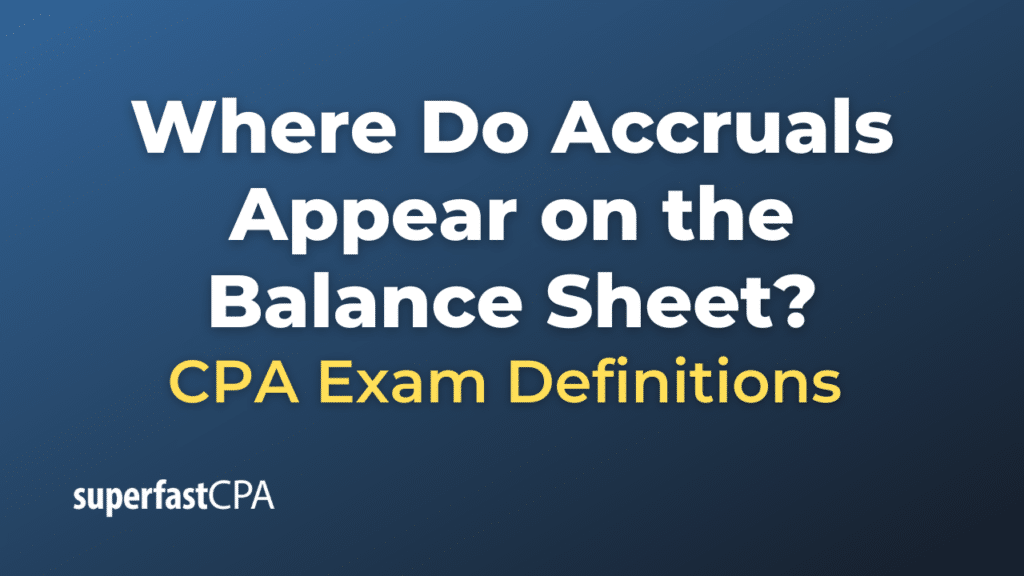Where Do Accruals Appear on the Balance Sheet
Accruals are accounting adjustments for revenues and expenses that have been incurred but not yet received or paid, respectively. In financial statements, accruals generally appear on the balance sheet as current liabilities or sometimes as current assets, depending on the nature of the accrual.
Current Liabilities
- Accounts Payable: These are amounts owed to suppliers for goods and services received but not yet paid for. While not strictly an accrual (because the expense has usually been invoiced), it’s similar in nature.
- Accrued Expenses: These are expenses like salaries or utilities that have been incurred but not yet paid. They are recorded to align with the accrual accounting method, which matches revenues and expenses in the period they are incurred, rather than when cash changes hands.
- Deferred Revenue: Also known as unearned revenue, this is money received in advance for services or goods to be provided in the future. While it’s a liability on the balance sheet, it’s an accrual of revenue to be recognized in future periods.
- Income Tax Payable: This represents the accrual for income taxes that are owed but not yet paid.
- Interest Payable: Accrued interest that has not yet been paid on loans or other obligations.
Current Assets
- Accounts Receivable: These are amounts expected to be received from customers for goods or services already delivered. While not strictly an accrual, it is similar in that it represents revenue that has been recognized but not yet collected.
- Prepaid Expenses: These are payments made for expenses that will be incurred in future periods, such as insurance premiums or rent. These expenses are initially recorded as assets and are expensed over time as they are consumed.
- Accrued Revenue: This is revenue that has been earned (for services rendered or goods delivered) but not yet billed. It is an asset on the balance sheet and will convert to cash as soon as the invoice is issued and payment is received.
Example of Where Do Accruals Appear on the Balance Sheet
Let’s look at a hypothetical example for a small software development company, “CodePerfect Inc.” This example will demonstrate how accruals for different types of revenue and expenses may appear on the balance sheet.
Scenario
- CodePerfect Inc. has completed work for a client, but the invoice for $10,000 has not yet been sent. This is “Accrued Revenue.”
- The company has used utility services for the month amounting to $500, but the bill has not yet arrived. This is an “Accrued Expense.”
- CodePerfect Inc. has received a $12,000 payment in advance from a customer for a 12-month software license. This is “Deferred Revenue.”
- The company has $8,000 in “Accounts Payable” for software licenses it has bought but not yet paid for.
- CodePerfect has a $3,000 “Income Tax Payable” for the quarter that is yet to be paid.
- The company has also “Prepaid” its rent for 6 months, amounting to $6,000.
Balance Sheet of CodePerfect Inc.
As of December 31, 2022
Assets
------
Current Assets:
Cash: $20,000
Accounts Receivable: $5,000
Prepaid Expenses (Rent): $6,000
Accrued Revenue: $10,000
------
Total Current Assets: $41,000
Liabilities
-----------
Current Liabilities:
Accounts Payable: $8,000
Accrued Expenses (Utilities): $500
Deferred Revenue: $12,000
Income Tax Payable: $3,000
------
Total Current Liabilities: $23,500
Equity
------
Owner's Equity: $17,500
------
Total Liabilities and Equity: $41,000Explanation:
- “Accrued Revenue” of $10,000 appears under Current Assets because it is expected to turn into cash within a year once the invoice is sent and the client pays.
- “Accrued Expenses” of $500 for utilities appears under Current Liabilities because this is an obligation that the company needs to pay.
- “Deferred Revenue” of $12,000 also appears under Current Liabilities. This will gradually move to the income statement as revenue as the company fulfills its service obligations over the year.
- “Accounts Payable” of $8,000 and “Income Tax Payable” of $3,000 also appear under Current Liabilities. These are amounts the company owes and will have to pay in the near term.
- “Prepaid Expenses” for rent appears under Current Assets. The company will recognize this as an expense over the next 6 months.
In this example, you can see how various types of accruals show up in different parts of the balance sheet. These items give a more accurate picture of the company’s financial health and obligations, in line with the principles of accrual accounting.













